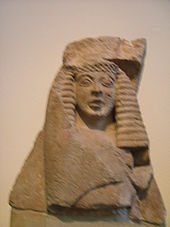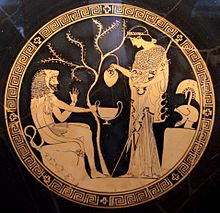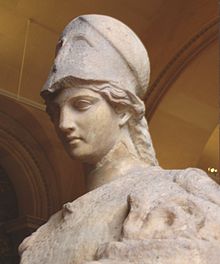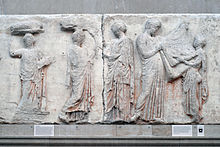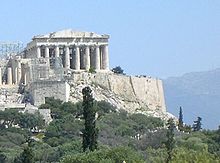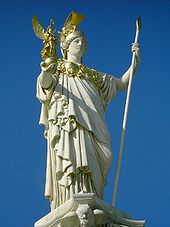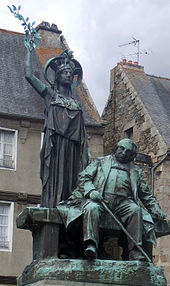- Athena
-
- "Athene", "Athina" and "Pallas Athena" all redirect here. For other uses, see Athena (disambiguation), Athene (disambiguation), Athina (disambiguation) and Pallas Athena (disambiguation)
Athena 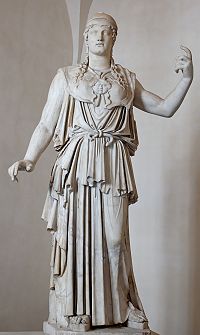
Marble Greek copy signed "Antiokhos", a first century BC variant of Phidias' fifth-century Athena Promachos that stood on the AcropolisGoddess of Wisdom, Warfare, Divine intelligence, and Crafts[1]
Patron Goddess of Athens[1]Abode Mount Olympus Symbol Owls, Olive trees, Snakes, Aegis, Armor, Helmets, Spears Parents Zeus and Metis[2] Siblings Porus[3] Roman equivalent Minerva  Features
Features- Hubris · Reciprocity · Virtue
Doctrines- Mythology · Orthopraxy · Polytheism
Practices- Amphidromia · Animal sacrifice · Iatromantis · Pharmakos · Temples · Votive Offerings
Deities- Twelve Olympians:
Aphrodite · Apollo · Ares · Artemis · Athena · Demeter · Dionysus · Hades · Hephaestus · Hera · Hermes · Hestia · Poseidon · Zeus
---
Primordial deities:
Aether · Chaos · Cronus · Erebus · Gaia · Hemera · Nyx · Tartarus · Uranus
---
Lesser gods:
Eros · Hebe · Hecate · Helios · Herakles · Iris · Nike · Pan · Selene
Texts- Argonautica · Bibliotheca · Iliad · Odyssey · Theogony · Works and Days
In Greek mythology, Athena, Athenê, or Athene (
 /əˈθiːnə/ or /əˈθiːniː/; Attic: Ἀθηνᾶ, Athēnā or Ἀθηναία, Athēnaia; Epic: Ἀθηναίη, Athēnaiē; Ionic: Ἀθήνη, Athēnē; Doric: Ἀθάνα, Athana), also referred to as Pallas Athena/Athene (
/əˈθiːnə/ or /əˈθiːniː/; Attic: Ἀθηνᾶ, Athēnā or Ἀθηναία, Athēnaia; Epic: Ἀθηναίη, Athēnaiē; Ionic: Ἀθήνη, Athēnē; Doric: Ἀθάνα, Athana), also referred to as Pallas Athena/Athene ( /ˈpæləs/; Παλλὰς Ἀθηνᾶ; Παλλὰς Ἀθήνη), is the goddess of wisdom, courage, inspiration, civilization, warfare, strength, strategy, the arts, crafts, justice, and skill. Minerva, Athena's Roman incarnation, embodies similar attributes.[4] Athena is also a shrewd companion of heroes and is the goddess of heroic endeavour. She is the virgin patron of Athens. The Athenians built the Parthenon on the Acropolis of her namesake city, Athens (Athena Parthenos), in her honour.[4]
/ˈpæləs/; Παλλὰς Ἀθηνᾶ; Παλλὰς Ἀθήνη), is the goddess of wisdom, courage, inspiration, civilization, warfare, strength, strategy, the arts, crafts, justice, and skill. Minerva, Athena's Roman incarnation, embodies similar attributes.[4] Athena is also a shrewd companion of heroes and is the goddess of heroic endeavour. She is the virgin patron of Athens. The Athenians built the Parthenon on the Acropolis of her namesake city, Athens (Athena Parthenos), in her honour.[4]Athena's veneration as the patron of Athens seems to have existed from the earliest times, and was so persistent that archaic myths about her were recast to adapt to cultural changes. In her role as a protector of the city (polis), many people throughout the Greek world worshiped Athena as Athena Polias (Ἀθηνᾶ Πολιάς "Athena of the city"). Athens and Athena bear etymologically connected names.[5]
Contents
Origin traditions
The Greek philosopher, Plato (429–347 BC), identified her with the Libyan deity Neith, the war goddess and huntress deity of the Egyptians since the ancient Pre-Dynastic period, who was also identified with weaving. This is sensible, as some Greeks identified Athena's birthplace, in certain mythological renditions, as being beside Libya's Triton River.[6] Classicist Martin Bernal created the "Black Athena Theory" to explain this associated origin by claiming that the conception of Neith was brought to Greece from Egypt, along with "an enormous number of features of civilization and culture in the third and second millennia."[7]
Patroness
Athena as the goddess of philosophy became an aspect of the cult in Classical Greece during the late 5th century BC.[8] She was the patroness of various crafts, especially of weaving, as Athena Ergane. The metalwork of weapons also fell under her patronage. She led battles (Athena Promachos or the warrior maiden Athena Parthenos)[9] as the disciplined, strategic side of war, in contrast to her brother Ares, the patron of violence, bloodlust and slaughter—"the raw force of war".[10] Athena's wisdom includes the cunning intelligence (metis) of such figures as Odysseus. Not only was this version of Athena the opposite of Ares in combat, it was also the polar opposite of the serene earth goddess version of the deity, Athena Polias.[9]
Athena appears in Greek mythology as the patron and helper of many heroes, including Odysseus, Jason, and Heracles. In Classical Greek myths, she never consorts with a lover, nor does she ever marry,[11] earning the title Athena Parthenos. A remnant of archaic myth depicts her as the adoptive mother of Erechtheus/Erichthonius through the foiled rape by Hephaestus.[12] Other variants relate that Erichthonius, the serpent that accompanied Athena, was born to Gaia: when the rape failed, the semen landed on Gaia and impregnated her. After Erechthonius was born, Gaia gave him to Athena.
Though Athena was a goddess of war strategy, she disliked fighting without purpose and preferred to use wisdom to settle predicaments.[13] The goddess only encouraged fighting for a reasonable cause or to resolve conflict. As patron of Athens she fought in the Trojan war on the side of the Achaeans.
Mythology
Birth
The Olympian version
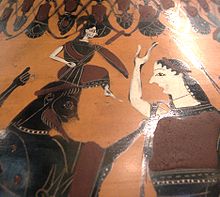 After he swallowed her pregnant mother, Metis, Athena is "born" from Zeus' forehead as he grasps the clothing of Eileithyia on the right —black-figured amphora, 550–525 BC, Louvre.
After he swallowed her pregnant mother, Metis, Athena is "born" from Zeus' forehead as he grasps the clothing of Eileithyia on the right —black-figured amphora, 550–525 BC, Louvre.
Although at Mycenaean Knossos Athena appears before Zeus does—in Linear B, as a-ta-na po-ti-ni-ja, "Mistress Athena"[14]—in the Classical Olympian pantheon, Athena was remade as the favorite daughter of Zeus, born fully armed from his forehead.[15] The story of her birth comes in several versions. In the one most commonly cited, Zeus lay with Metis, the goddess of crafty thought and wisdom, but he immediately feared the consequences. It had been prophesied that Metis would bear children more powerful than the sire,[16] even Zeus himself. In order to forestall these dire consequences, after lying with Metis, Zeus "put her away inside his own belly;" he "swallowed her down all of a sudden."[17] He was too late: Metis had already conceived.
Eventually Zeus experienced an enormous headache; Prometheus, Hephaestus, Hermes, Ares,or Palaemon[disambiguation needed
 ] (depending on the sources examined) cleaved Zeus's head with the double-headed Minoan axe, the labrys. Athena leaped from Zeus's head, fully grown and armed, with a shout— "and pealed to the broad sky her clarion cry of war. And Ouranos trembled to hear, and Mother Gaia..." (Pindar, Seventh Olympian Ode). Plato, in the Laws, attributes the cult of Athena to the culture of Crete, introduced, he thought, from Libya during the dawn of Greek culture.
] (depending on the sources examined) cleaved Zeus's head with the double-headed Minoan axe, the labrys. Athena leaped from Zeus's head, fully grown and armed, with a shout— "and pealed to the broad sky her clarion cry of war. And Ouranos trembled to hear, and Mother Gaia..." (Pindar, Seventh Olympian Ode). Plato, in the Laws, attributes the cult of Athena to the culture of Crete, introduced, he thought, from Libya during the dawn of Greek culture.Classical myths thereafter note that Hera was so annoyed at Zeus producing a child that she conceived and bore Hephaestus by herself.
Plato, in Cratylus (407B) gave the etymology of her name as signifying "the mind of god", theou noesis. The Christian apologist of the 2nd century Justin Martyr takes issue with those pagans who erect at springs images of Kore, whom he interprets as Athena:
"They said that Athena was the daughter of Zeus not from intercourse, but when the god had in mind the making of a world through a word (logos) his first thought was Athena"[18]
John Milton's Paradise Lost interprets this myth as a model for the birth of Sin from the head of Satan.[19]
Pallas Athena
The major competing tradition regarding Athena's parentage involves some of her more mysterious epithets: Pallas, as in the ancient-Greek Παλλάς Άθήνη (also Pallantias) and Tritogeneia (also Trito, Tritonis, Tritoneia, Tritogenes). A distant archaic separate entity named Pallas is invoked (literate Greeks cannot remember the gender) as Athena's father, sister, foster sister, companion, or opponent in battle. Pallas is often a nymph, a daughter of Triton (a sea god), and a childhood friend of Athena.[20] In every case, Athena kills Pallas, accidentally, and thereby gains the name for herself. In one telling, they practice the arts of war together until one day they have a falling out. As Pallas is about to strike Athena, Zeus intervenes. With Pallas stunned by a blow from Zeus, Athena takes advantage and kills her. Distraught over what she has done, Athena takes the name Pallas for herself.
When Pallas is Athena's father the events, including her birth, are located near a body of water named Triton or Tritonis. When Pallas is Athena's sister or foster-sister, Athena's father or foster-father is Triton, the son and herald of Poseidon. But Athena may be called the daughter of Poseidon and a nymph named Tritonis, without involving Pallas. Likewise, Pallas may be Athena's father or opponent, without involving Triton.[21] On this topic, Walter Burkert says "she is the Pallas of Athens, Pallas Athenaie, just as Hera of Argos is Here Argeie.[22] For the Athenians, Burkert notes, Athena was simply "the Goddess", he thea, certainly an ancient title.
Athena Parthenos: Virgin Athena
Athena never had a consort or lover and was thus known as Athena Parthenos, "Virgin Athena". Her most famous temple, the Parthenon, on the Acropolis in Athens takes its name from this title. It was not merely an observation of her virginity, but a recognition of her role as enforcer of rules of sexual modesty and ritual mystery. Even beyond recognition, the Athenians allotted the goddess value based on this pureness of virginity as it upheld a rudiment of female behavior in the patriarchal society. Kerenyi's study and theory of Athena accredits her virginal toponym to be a result of the relationship to her father Zeus and a vital, cohesive piece of her character throughout the ages.[23] This role is expressed in a number of stories about Athena. Marinus[disambiguation needed
 ] reports that when Christians removed the statue of the Goddess from the Parthenon, a beautiful woman appeared in a dream to Proclus, a devotee of Athena, and announced that the "Athenian Lady" wished to dwell with him.[24]
] reports that when Christians removed the statue of the Goddess from the Parthenon, a beautiful woman appeared in a dream to Proclus, a devotee of Athena, and announced that the "Athenian Lady" wished to dwell with him.[24]Erichthonius
Hephaestus attempted to rape Athena, but she eluded him. His semen fell to the earth and impregnated the soil, and Erichthonius was born from the Earth, Gaia. Athena then raised the baby as a foster mother.[25]
Athena puts the infant Erichthonius in a small box (cista) which she entrusts to the care of three sisters, Herse, Pandrosus, and Aglaulus of Athens. The goddess does not tell them what the box contains, but warns them not to open it until she returns. One or two sisters opens the cista to reveal Erichthonius, in the form (or embrace) of a serpent. The serpent, or insanity induced by the sight, drives Herse and Aglaulus to throw themselves off the Acropolis.[26] Jane Harrison (Prolegomena) finds this to be a simple cautionary tale directed at young girls carrying the cista in the Thesmophoria rituals, to discourage them from opening it outside the proper context.
Another version of the myth of the Athenian maidens is told in Metamorphoses by the Roman poet Ovid (43 BC – 17 AD); in this late variant Hermes falls in love with Herse. Herse, Aglaulus, and Pandrosus go to the temple to offer sacrifices to Athena. Hermes demands help from Aglaulus to seduce Herse. Aglaulus demands money in exchange. Hermes gives her the money the sisters have already offered to Athena. As punishment for Aglaulus's greed, Athena asks the goddess Envy to make Aglaulus jealous of Herse. When Hermes arrives to seduce Herse, Aglaulus stands in his way instead of helping him as she had agreed. He turns her to stone.[27]
With this mythic origin, Erichthonius became the founder-king of Athens, and many beneficial changes to Athenian culture were ascribed to him. During this time, Athena frequently protected him.
Medusa and Tiresias
In a late myth, Medusa, unlike her two sister Gorgons, came to be thought of by the Classical Greeks during the 5th century as mortal and extremely beautiful and she was a priestess in Athena's temple. Poseidon, in the temple of Athena and Hephasteus, raped Medusa because he refused to allow her vow of chastity to stand in his way.[28] Upon discovering the desecration of her temple, Athena changed Medusa's form to match that of her sister Gorgons as punishment. Medusa's hair turned into snakes, her lower body was transformed also, and meeting her gaze would turn any living man to stone. In the earliest myths, there is only one Gorgon, but there are two snakes that form a belt around her waist.
In one version of the Tiresias myth, Tiresias stumbled upon Athena bathing, and he was struck blind by her to ensure he would never again see what man was not intended to see. But having lost his eyesight, he was given a special gift - to be able to understand the language of the birds (and thus to foretell the future).
Lady of Athens
Athena competed with Poseidon to be the patron deity of Athens, which was yet unnamed, in a version of one founding myth. They agreed that each would give the Athenians one gift and that the Athenians would choose the gift they preferred. Poseidon struck the ground with his trident and a spring sprang up; this gave them a means of trade and water —Athens at its height was a significant sea power, defeating the Persian fleet at the Battle of Salamis— but the water was salty and not very good for drinking. Athena, however, offered them the first domesticated olive tree. The Athenians (or their king, Cecrops) accepted the olive tree and with it the patronage of Athena, for the olive tree brought wood, oil, and food. Robert Graves was of the opinion that "Poseidon's attempts to take possession of certain cities are political myths" which reflect the conflict between matriarchal and patriarchal religions.[29]
Other sites of cult
Athena also was the patron goddess of several other Greek cities, notably Sparta, where the archaic cult of Athena Alea had its sanctuaries in the surrounding villages of Alea, Mantineia and, notably, Tegea. Tegea was an important religious center of ancient Greece,[30] containing the Temple of Athena Alea. The temenos was founded by Aleus, Pausanias was informed.[31] Votive bronzes at the site from the Geometric and Archaic periods take the forms of horses and deer; there are sealstone and fibulae. In the Archaic period the nine villages that underlie Tegea banded together in a synoecism to form one city.[32] Tegea was listed in Homer's Catalogue of Ships as one of the cities that contributed ships and men for the Achaean assault on Troy.
 Helmeted Athena, of the Velletri type; a Roman copy (first century) of a Greek original by Kresilas, c. 430 BC.
Helmeted Athena, of the Velletri type; a Roman copy (first century) of a Greek original by Kresilas, c. 430 BC.
Counselor
Later myths of the Classical Greeks relate that Athena guided Perseus in his quest to behead Medusa. She instructed Heracles to skin the Nemean Lion by using its own claws to cut through its thick hide. She also helped Heracles to defeat the Stymphalian Birds, and to navigate the underworld so as to capture Cerberus.
In The Odyssey, Odysseus' cunning and shrewd nature quickly won Athena's favour. In the realistic epic mode, however, she largely is confined to aiding him only from afar, as by implanting thoughts in his head during his journey home from Troy. Her guiding actions reinforce her role as the "protectress of heroes" or as mythologian Walter Friedrich Otto dubbed her the "goddess of nearness" due to her mentoring and motherly probing.[33] It is not until he washes up on the shore of an island where Nausicaa is washing her clothes that Athena arrives personally to provide more tangible assistance. She appears in Nausicaa's dreams to ensure that the princess rescues Odysseus and plays a role in his eventual escort to Ithaca.
Athena appears in disguise to Odysseus upon his arrival, initially lying and telling him that Penelope, his wife, has remarried and that he is believed to be dead; but Odysseus lies back to her, employing skillful prevarications to protect himself.[34] Impressed by his resolve and shrewdness, she reveals herself and tells him what he needs to know in order to win back his kingdom. She disguises him as an elderly man or beggar so that he cannot be noticed by the suitors or Penelope, and helps him to defeat the suitors. She also plays a role in ending the resultant feud against the suitors' relatives, although she seems strange to readers. She instructs Laertes to throw his spear and to kill the father of Antinous, Eupeithes. But she must have forgotten her task of bringing peace to Ithaca and wiping the thought of slaughter from the suitors' families, because she suddenly told them to stop fighting.
The Judgment of Paris
Main article: Judgement of Paris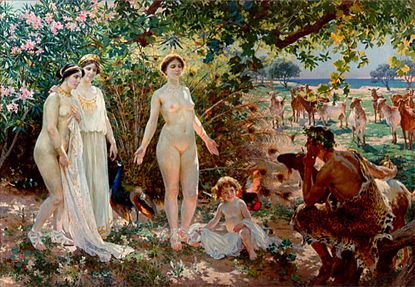 Aphrodite is being surveyed by Paris, while Athena (the leftmost figure) and Hera stand by. El Juicio de Paris by Enrique Simonet, ca. 1904
Aphrodite is being surveyed by Paris, while Athena (the leftmost figure) and Hera stand by. El Juicio de Paris by Enrique Simonet, ca. 1904
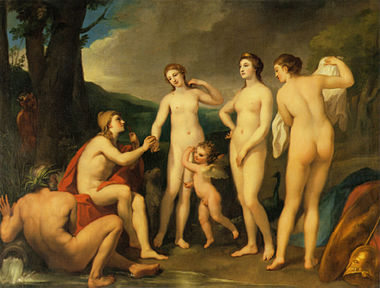 Paris is awarding the apple to Aphrodite, while Athena makes a face. Urteil des Paris by Anton Raphael Mengs, ca. 1757
Paris is awarding the apple to Aphrodite, while Athena makes a face. Urteil des Paris by Anton Raphael Mengs, ca. 1757
All the gods and goddesses as well as various mortals were invited to the marriage of Peleus and Thetis (the eventual parents of Achilles). Only Eris, goddess of discord, was not invited. She was annoyed at this, so she arrived with a golden apple inscribed with the word καλλίστῃ (kallistēi, "for the fairest one"), which she threw among the goddesses. Aphrodite, Hera, and Athena all claimed to be the fairest, and thus the rightful owner of the apple.
The goddesses chose to place the matter before Zeus, who, not wanting to favor one of the goddesses, put the choice into the hands of Paris, a Trojan prince. After bathing in the spring of Mount Ida (where Troy was situated), the goddesses appeared to Paris naked, but Paris couldn't decide, so they resorted to bribes. Hera tried to bribe Paris with control over all Asia and Europe, while Athena offered wisdom, fame and glory in battle, but Aphrodite came forth and whispered to Paris that if he were to choose her as the fairest he would have the most beautiful mortal woman in the world as a wife, and he accordingly chose her. This woman was Helen, who was, unfortunately for Paris, already married to King Menelaus of Sparta. The other two goddesses were enraged by this and through Helen's abduction by Paris they brought about the Trojan War.
This is one of the few, if any, myths where Athena didn't act out of her better judgment, for obvious reasons.
Roman fable of Arachne
The fable of Arachne is a late Roman addition to Classical Greek mythology[35] but does not appear in the myth repertoire of the Attic vase-painters. Arachne's name simply means spider (αράχνη). Arachne was the daughter of a famous dyer in Tyrian purple in Hypaipa of Lydia, and a weaving student of Athena. She became so conceited of her skill as a weaver that she began claiming that her skill was greater than that of Athena herself.
Athena gave Arachne a chance to redeem herself by assuming the form of an old woman and warning Arachne not to offend the deities. Arachne scoffed and wished for a weaving contest, so she could prove her skill.
Athena wove the scene of her victory over Poseidon that had inspired her patronage of Athens. According to Ovid's Latin narrative, Arachne's tapestry featured twenty-one episodes of the infidelity of the deities, including Zeus being unfaithful with Leda, with Europa, and with Danaë. Athena admitted that Arachne's work was flawless, but was outraged at Arachne's offensive choice of subjects that displayed the failings and transgressions of the deities. Finally, losing her temper, Athena destroyed Arachne's tapestry and loom, striking it with her shuttle. Athena then struck Arachne with her staff, which changed her into a spider. In some versions, the destruction of her loom leads Arachne to hang herself in despair; Athena takes pity on her, and transforms her into a spider.
The fable suggests that the origin of weaving lay in imitation of spiders and that it was considered to have been perfected first in Asia Minor.
Cult and attributes
Athena's epithets include Άτρυτώνη, Atrytone (= the unwearying), Παρθένος, Parthénos (= virgin), and Ή Πρόμαχος, Promachos (the First Fighter, i. e. she who fights in front).
In poetry from Homer, an oral tradition of the eighth or 7th century BC, onward, Athena's most common epithet is glaukopis (γλαυκώπις), which usually is translated as, bright-eyed or with gleaming eyes.[36] The word is a combination of glaukos (γλαύκος, meaning gleaming, silvery, and later, bluish-green or gray) and ops (ώψ, eye, or sometimes, face). It is interesting to note that glaux (γλαύξ, "owl") is from the same root, presumably because of the bird's own distinctive eyes. The bird which sees well in the night is closely associated with the goddess of wisdom: in archaic images, Athena is frequently depicted with an owl perched on her head. This pairing evolved in tangent so that even in present day the owl is upheld as a symbol of perspicacity and erudition.[4] Unsurprisingly, the owl became a sort of Athenian mascot. The olive tree is likewise sacred to her. In earlier times, Athena may well have been a bird goddess, similar to the unknown goddess depicted with owls, wings, and bird talons on the Burney relief, a Mesopotamian terracotta relief of the early second millennium BC.[citation needed]
Other epithets include: Aethyta under which she was worshiped in Megara.[37] The word aithyia (αίθυια) signifies a diver, and figuratively, a ship, so the name must reference Athena teaching the art of shipbuilding or navigation.[38][39] In a temple at Phrixa in Elis, which was reportedly built by Clymenus, she was known as Cydonia.[40]
The various Athena subgroups, or cults, all branching from the central goddess herself often proctored various initiation rites of Grecian youth, for example, the passage into citizenship by young men and for women the elevation to the status of citizen wife. Her various cults were portals of a uniform socialization, even beyond mainland Greece.[41]
Epithets
In the Iliad (4.514), the Homeric Hymns, and in Hesiod's Theogony, Athena is given the curious epithet Tritogeneia. The meaning of this term is unclear. It seems to mean "Triton-born", perhaps indicating that the sea-deity was her parent according to some early myths,[42] In Ovid's Metamorphoses Athena is occasionally referred to as "Tritonia."
Another possible meaning may be triple-born or third-born, which may refer to a triad or to her status as the third daughter of Zeus or the fact she was born from Metis, Zeus, and herself; various legends list her as being the first child after Artemis and Apollo, though other legends[citation needed] identify her as Zeus' first child. The latter would have to be drawn from Classical myths, however, rather than earlier ones.
In her role as judge at Orestes' trial on the murder of his mother, Clytemnestra (which he won), Athena won the epithet Athena Areia.
A new peplos was woven for Athena and ceremonially brought to dress her cult image (British Museum).
Other epithets were Ageleia and Itonia.
Athena was given many other cult titles. She had the epithet Athena Ergane as the patron of craftsmen and artisans. With the epithet Athena Parthenos ("virgin") she was especially worshipped in the festivals of the Panathenaea and Pamboeotia where both militaristic and athletic displays took place.[43] With the epithet Athena Promachos she led in battle. With the epithet Athena Polias ("of the city"), Athena was the protector of not only Athens but also of many other cities, including Argos, Sparta, Gortyn, Lindos, and Larisa.
She was given the epithet Athena Hippeia or Athena Hippia, horse as the inventor of the chariot, and was worshipped under this title at Athens, Tegea and Olympia. As Athena Hippeia she was given an alternative parentage: Poseidon and Polyphe, daughter of Oceanus.[44][45] In each of these cities her temple frequently was the major temple on the acropolis.[46]
Athena often was equated with Aphaea, a local goddess of the island of Aegina, located near Athens, once Aegina was under Athenian's power. The Greek historian Plutarch (46 AD–120 AD) also refers to an instance during the Parthenon's construction of her being called Athena Hygieia ("healer"):
A strange accident happened in the course of building, which showed that the goddess was not averse to the work, but was aiding and co-operating to bring it to perfection. One of the artificers, the quickest and the handiest workman among them all, with a slip of his foot fell down from a great height, and lay in a miserable condition, the physicians having no hope of his recovery. When Pericles was in distress about this, the goddess [Athena] appeared to him at night in a dream, and ordered a course of treatment, which he applied, and in a short time and with great ease cured the man. And upon this occasion it was that he set up a brass statue of Athena Hygeia, in the citadel near the altar, which they say was there before. But it was Phidias who wrought the goddess's image in gold, and he has his name inscribed on the pedestal as the workman of it.[47]In classical times the Plynteria, or “Feast of Adorning”, was observed every May, it was a festival lasting five days. During this period the Priestesses of Athena, or “Plyntrides”, performed a cleansing ritual within “the Erecththeum”, the personal sanctuary of the goddess. Here Athena's statue was undressed, her clothes washed, and body purified.
In Arcadia, she was assimilated with the ancient goddess Alea and worshiped as Athena Alea.
In Classical art
 The Athena Giustiniani, a Roman copy of a Greek statue of Pallas Athena with her serpent, Erichthonius.
The Athena Giustiniani, a Roman copy of a Greek statue of Pallas Athena with her serpent, Erichthonius.
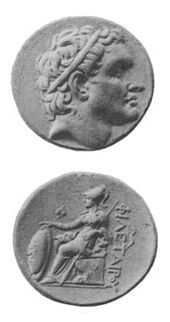 Athena depicted on a coin of Attalus I, ruler of Pergamon —c. 200 BC.
Athena depicted on a coin of Attalus I, ruler of Pergamon —c. 200 BC.
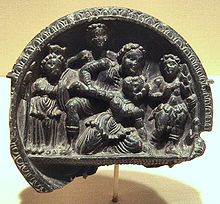 Mythological scene with Athena (left) and Herakles (right), on a stone palette of the Greco-Buddhist art of Gandhara, India.
Mythological scene with Athena (left) and Herakles (right), on a stone palette of the Greco-Buddhist art of Gandhara, India.
Classically, Athena is portrayed wearing a full- length chiton, and sometimes in armor, with her helmet raised high on the forehead to reveal the image of Nike. Her shield bears at its centre the aegis with the head of the gorgon (gorgoneion) in the center and snakes around the edge. It is in this standing posture that she was depicted in Phidias's famous lost gold and ivory statue of her, 36 m tall, the Athena Parthenos in the Parthenon. Athena also often is depicted with an owl sitting on one of her shoulders.[48] The Mourning Athena is a relief sculpture that dates around 460 BC and portrays a weary Athena resting on a staff. In earlier, archaic portraits of Athena in Black-figure pottery, the goddess retains some of her Minoan-Mycenaean character, such as great bird wings although this is not true of archaic sculpture such as those of Aphaean Athena, where Athena has subsumed an earlier, invisibly numinous —Aphaea— goddess with Cretan connections in her mythos.Other commonly received and repeated types of Athena in sculpture may be found in this list.
Apart from her attributes, there seems to be a relative consensus in late sculpture from the Classical period, the 5th century onward, as to what Athena looked like. Most noticeable in the face is perhaps the full round strong, masculine chin with a high nose that has a high bridge as a natural extension of the forehead. The eyes typically are somewhat deeply set. The unsmiling lips are usually full, but the mouth is depicted fairly narrow, usually just slightly wider than the nose. The neck is somewhat long. The net result is a serene, serious, somewhat aloof, and very masculine beauty.
Name, etymology, and origin
Athena had a special relationship with Athens, as is shown by the etymological connection of the names of the goddess and the city. The citizens of Athens built a statue of Athena as a temple to the goddess, which had piercing eyes, a helmet on her head, attired with an aegis or cuirass, and an extremely long spear. It also had a crystal shield with the head of the Gorgon on it. A large snake accompanied her and she held the goddess of victory in her hand.
 Bust of Athena in the Glyptothek
Bust of Athena in the Glyptothek
Athena is associated with Athens, a plural name because it was the place where she presided over her sisterhood, the Athenai, in earliest times: Mycenae was the city where the Goddess was called Mykene, and Mycenae is named in the plural for the sisterhood of females who tended her there. At Thebes she was called Thebe, and the city again a plural, Thebae (or Thebes, where the "s" is the plural formation). Similarly, at Athens she was called Athena, and the city Athenae (or Athens, again a plural)."[49] Whether her name is attested in Eteocretan or not will have to wait for decipherment of Linear A.
Günther Neumann has suggested that Athena's name is possibly of Lydian origin;[50] it may be a compound word derived in part from Tyrrhenian "ati", meaning mother and the name of the Hurrian goddess "Hannahannah" shortened in various places to "Ana"[citation needed]. In Mycenaean Greek, at Knossos a single inscription A-ta-na po-ti-ni-ja /Athana potniya/ appears in the Linear B tablets from the Late Minoan II-era "Room of the Chariot Tablets"; these comprise the earliest Linear B archive anywhere.[51][52] Although Athana potniya often is translated Mistress Athena, it literally means "the potnia of At(h)ana", which perhaps, means the Lady of Athens;[53] Any connection to the city of Athens in the Knossos inscription is uncertain.[54] We also find A-ta-no-dju-wa-ja /Athana diwya/, the final part being the Linear B spelling of what we know from Ancient Greek as Diwia (Mycenaean di-u-ja or di-wi-ja): divine Athena also was a weaver and the deity of crafts (see dyeus).[55]
In his dialogue Cratylus, the Greek philosopher Plato, 428/427 BC – 348/347 BC, gives the etymology of Athena's name, based on the view of the ancient Athenians:
That is a graver matter, and there, my friend, the modern interpreters of Homer may, I think, assist in explaining the view of the ancients. For most of these in their explanations of the poet, assert that he meant by Athena "mind" [nous] and "intelligence" [dianoia], and the maker of names appears to have had a singular notion about her; and indeed calls her by a still higher title, "divine intelligence" [Theian noesis], as though he would say: This is she who has the mind better than others. Nor shall we be far wrong in supposing that the author of it wished to identify this Goddess with moral intelligence [en ethei noesin], and therefore gave her the name etheonoe; which, however, either he or his successors have altered into what they thought a nicer form, and called her Athena.—Plato, Cratylus, 407bThus for Plato her name was to be derived from Greek Ἀθεονόα, Atheonóa —which the later Greeks rationalised as from the deity's (theos) mind (nous).
The Greek historian, Herodotus (c. 484–425 BC), noted that the Egyptian citizens of Sais in Egypt worshipped a goddess whose Egyptian name was Neith;[56] and they identified her with Athena. (Timaeus 21e), (Histories 2:170–175).
Some authors[citation needed] believe that, in early times, Athena was either an owl herself or a bird goddess in general: in Book 3 of the Odyssey, she takes the form of a sea-eagle. These authors argue that she dropped her prophylactic owl-mask before she lost her wings. "Athena, by the time she appears in art," Jane Ellen Harrison had remarked, "has completely shed her animal form, has reduced the shapes she once wore of snake and bird to attributes, but occasionally in black-figure vase-paintings she still appears with wings."[57]
Some Greek authors[who?] have derived natural symbols from the etymological roots of Athena's names to be aether, air, earth, and moon. This was one of the primary developments of scholarly exploration in the ancient world.[58]
Post-classical culture
A neoclassical variant of Athena Promachos stands in front of the Austrian Parliament Building in Vienna.
A brief summary of Athena's evolution of myriad motifs after her dominance in Greece may be seen as follows: The rise of Christianity in Greece largely ended the worship of Greek deities and polytheism in general, but she resurfaced in the Middle Ages as a defender of sagacity and virtue so that her masculine warrior status was still intact. (She may be found on some family crests of nobility.) During the Renaissance she donned the mantle of patron of the arts and human endeavor and finally although not ultimately, Athena personified the miracles of freedom and republic during the French Revolution. (A statue of the goddess was centered on the Place de la Revolution in Paris.)[4]
For over a century a full-scale replica of the Parthenon has stood in Nashville, Tennessee, which is known as the Athens of the South. In 1990, a gilded 41 feet (12.5 m) tall replica of Phidias' statue of Athena Parthenos was added. The state seal of California features an image of Athena (or Minerva) kneeling next to a brown grizzly bear.[59]
Athena is a natural patron of universities: she is the symbol of the Darmstadt University of Technology, in Germany, and the Federal University of Rio de Janeiro, in Brazil. Her image can be found in the shields of the Faculty of Philosophy and Letters and the Faculty of Sciences of the National Autonomous University of Mexico, where her owl is the symbol of the Faculty of Chemistry. At Bryn Mawr College in Pennsylvania a statue of Athena (a replica of the original bronze one in the arts and archaeology library) resides in the Great Hall. It is traditional at exam time for students to leave offerings to the goddess with a note asking for good luck, or to repent for accidentally breaking any of the college's numerous other traditions. Athena's owl also serves as the mascot of the college, and one of the college hymns is "Pallas Athena". Pallas Athena is the tutelary goddess of the international social fraternity Phi Delta Theta.[60] Her owl is also a symbol of the fraternity.[60]
The title character in Edgar Allan Poe's "The Raven" famously sits upon "a Bust of Pallas".
She is the symbol of the United States Women's Navy and was depicted on their Unit Crest. A medal awarded to women who served in the Women Army Auxiliary Corps from 10 July 1942 to 31 August 1943, and to the Women Army Corps from 1 September 1943 to 2 September 1945 featured Athena on the front.
Athena's Helmet is the central feature on the United States Military Academy crest.
Athena is reported as a source of influence for feminist theologians such as Carol P. Christ.
Jean Boucher's statue of the seated skeptical thinker Ernest Renan, shown to the left, caused great controversy when it was installed in Tréguier, Brittany in 1902. Renan's 1862 biography of Jesus had denied his divinity, and he had written the "Prayer on the Acropolis" addressed to the goddess Athena. The statue was placed in the square fronted by the cathedral. Renan's head was turned away from the building, while Athena, beside him, was depicted raising her arm, which was interpreted as indicating a challenge to the church during an anti-clerical phase in French official culture. The installation was accompanied by a mass protest from local Roman Catholics and a religious service against the growth of skepticism and secularism.[61]
Athena has been used numerous times as a symbol of a republic by different countries and appears on currency as she did on the ancient drachma of Athens. Athena (Minerva) is the subject of the $50 1915-S Panama-Pacific commemorative coin. At 2.5 troy oz (78 g) gold, this is the largest (by weight) coin ever produced by the U.S. Mint. This was the first $50 coin issued by the U.S. Mint and no higher was produced until the production of the $100 platinum coins in 1997. Of course, in terms of face-value in adjusted dollars, the 1915 is the highest denomination ever issued by the U.S. Mint.
Athena was depicted on the obverse of the Greek 100 drachmas banknote of 1978-2001.[62] Another recent example is the 60 Years of the Second Republic commemorative coin issued by Austria in 2005. Athena is depicted in the obverse of the coin, representing the Austrian Republic.
She appears briefly in Disney's Hercules, but has a more dominant role in the television series.
Athena is an active character in Marvel Comics' main continuity, the Marvel Universe, most recently in the Incredible Hercules series. She acts as a guide to Hercules and his sidekick, boy genius Amadeus Cho.
Athena appears in Rick Riordan's Percy Jackson and the Olympians book series. Her daughter, born from her head as she was from Zeus's, demigod Annabeth Chase is one of the principal characters. Annabeth's father found her (Annabeth) lying in a golden cradle at the doorstep.
The Roman name for Athena is Minerva. In the video game Assassin's Creed Brotherhood, Minerva appears in an ancient vault underneath the Colosseum at the end of the game. She explains the origin of mankind within the story to the game's main protagonist, Desmond Miles.
Athena appears in the TV series Stargate SG1 when she kidnaps Vala Mal Doran to gain information on the Clava Thessara Infinitas (The Key to Infinite Treasure).
Masculinity and feminism
Athena had an "androgynous compromise" that allowed her traits and what she stood for to be attributed to male and female rulers alike over the course of history (such as Marie de Medici, Anne of Austria, Christina of Sweden, and Catherine the Great).[63]
J.J. Bachofen advocated that Athena was originally a maternal figure stable in her security and poise but was caught up and perverted by a patriarchal society; this was especially the case in Athens. The goddess adapted but could very easily be seen as a god. He viewed it as "motherless paternity in the place of fatherless maternity" where once altered, Athena's character was to be crystallized as that of a patriarch.[64]
Whereas Bachofen saw the switch to paternity on Athena's behalf as an increase of power, Freud on the contrary perceived Athena as an "original mother goddess divested of her power". In this interpretation, Athena was demoted to be only Zeus's daughter, never allowed the expression of motherhood. Still more different from Bachofen's perspective is the lack of role permanency in Freud's view: Freud held that time and differing cultures would mold Athena to stand for what was necessary to them.[65]
See also
- Athenaeum (disambiguation)
- Palladium (mythology)
Footnotes
- ^ a b "Athena". Myths Encyclopedia. http://www.mythencyclopedia.com/Ar-Be/Athena.html. Retrieved 2009-11-24.
- ^ According to Hesiod's Theogony, Metis was Athena's mother, but, according to Homer's Iliad, she sprang forth from Zeus' head and had no mother.
- ^ Porus was Athena's half-brother because he was the son of Metis alone while Athena was the daughter of Zeus and, according to Hesiod, Metis.
- ^ a b c d Deacy, Susan, and Alexandra Villing. Athena in the Classical World. Koninklijke Brill NV, Leiden, The Netherlands: Brill, 2001. Print.
- ^ "Whether the goddess was named after the city or the city after the goddess is an ancient dispute" (Burkert 1985:139)
- ^ Aeschylus Eumenides. 292–293. Cf. the tradition that she was the daughter of Neilos: see, e.g. Clement of Alexandria Protr. 2.28.2; Cicero, De Natura Deorum. 3.59.
- ^ M. . Bernal, Black Athena: The Afroasiatic Roots of Classical Civilization (New Brunswick: Rutgers University Press, 1987), 21, 51–53.
- ^ Walter Burkert, Greek Religion 1985:VII "Philosophical Religion" treats these transformations.
- ^ a b C.J. Herrington, Athena Parthenos and Athena Polias. Manchester: Manchester University Press, 1955
- ^ Darmon."Athena and Ares". Chicago and London: University of Chicago Press, 1978.
- ^ S. Goldhill. Reading Greek Tragedy(Aesch.Eum.737). Cambrdige: Cambridge University Press, 1986.
- ^ Pseudo-Apollodorus, Bibliotheke 3.14.6.
- ^ Loewen, Nancy. Athena. ISBN 0736800484.
- ^ Knossos tablet V 52 (John Chadwick, The Mycenaean World [Cambridge] 1976:88 fig 37.) Athana Potnia does not appear at Mycenaean Pylos, where the mistress goddess is ma-te-re te-i-ja, Mater Theia, literally "Mother Goddess".
- ^ Jane Ellen Harrison's famous characterisation of this myth-element as, "a desperate theological expedient to rid an earth-born Kore of her matriarchal conditions" has never been refuted (Harrison 1922:302).
- ^ Compare the prophecy concerning Thetis.
- ^ Hesiod, Theogony 890ff and 924ff.
- ^ Justin, Apology 64.5. quoted in Robert McQueen Grant, Gods and the One God, vol 1 :155, who observes that it is Porphyry "who similarly identifies Athena with "forethought".
- ^ B.Spaanstra-Polak,"The Birth of Athena: An Emblematic Representation"-Album Amicorum J.G. van Gelder, ed. J.Bruyn, J. Emmens, et al. The Hague:Martinus Nijhoff, 1973.293-305.
- ^ "Pallas". Theoi.com. http://www.theoi.com/Nymphe/NymphePallas.html. Retrieved 2011-07-24.
- ^ Graves, Robert, The Greek Myths I, "The Birth of Athena", 8.a., p. 51. The story comes from Libyan (modern Berbers) where the Greek Athena and the Egyptian Neith blend into one deity. The story is not often referenced because some of the details are contradicted by other, better-documented theories. Frazer, vol. 2 p.41
- ^ Burkert, p. 139.
- ^ K.Kerenyi,Die Jungfrau und Mutter der griechischen Religion. Eine Studie uber Pallas Athene.Zurich:Rhein Verlag, 1952.
- ^ Marinus of Samaria, "The Life of Proclus or Concerning Happiness", Translated by Kenneth S. Guthrie (1925), pp.15–55:30, retrieved 21 May 2007.Marinus, Life of Proclus
- ^ Pseudo-Apollodorus, Bibliotheke 3.14.6.
- ^ Graves, Robert, The Greek Myths I, "The Nature and Deeds of Athena" 25.d.
- ^ Ovid, Metamorphoses, X. Aglaura, Book II, 708–751; XI. The Envy, Book II, 752–832.
- ^ "Medusa in Myth and Literary History". http://www.english.illinois.edu/maps/poets/a_f/bogan/medusamyth.htm. Retrieved 2010-01-06.
- ^ Graves 1960:16.3p 62.
- ^ "This sanctuary had been respected from early days by all the Peloponnesians, and afforded peculiar safety to its suppliants" (Pausanias, Description of Greece iii.5.6)
- ^ Pausanias, Description of Greece viii.4.8.
- ^ Compare the origin of Sparta.
- ^ W.F.Otto,Die Gotter Griechenlands(55-77).Bonn:F.Cohen,1929
- ^ Trahman in Phoenix, p. 35.
- ^ The Arachne narrative is in Ovid's Metamorphoses (vi.5-54 and 129-145) and mentioned in Virgil's Georgics, iv, 246.
- ^ Henry George Liddell, Robert Scott, 1940, A Greek-English Lexicon, ISBN 0-19-864226-1, online version at the Perseus Project.
- ^ Pausanias, i. 5. § 3; 41. § 6
- ^ John Tzetzes, ad Lycophr., l.c.
- ^ Schmitz, Leonhard (1867). "Aethyta". In Smith, William. Dictionary of Greek and Roman Biography and Mythology. 1. Boston, MA. p. 51. http://www.ancientlibrary.com/smith-bio/0060.html.
- ^ Smith, Dictionary of Greek and Roman Biography and Mythology.
- ^ P.Schmitt,"Athena Apatouria et la ceinture: Les aspects feminis des apatouries a Athenes"in Annales:Economies, Societies, Civilisations(1059-1073).London:Thames and Hudson,2000.
- ^ Karl Kerenyi suggests that "Tritogeneia did not mean that she came into the world on any particular river or lake, but that she was born of the water itself; for the name Triton seems to be associated with water generally." (Kerenyi, p. 128).
- ^ Robertson,Noel.Festivals and Legends:The Formation of Greek Cities in the Light of Public Ritual.Toronto:University of Toronto Press,1992.
- ^ "POLYPHE: Oceanid nymph of Rhodes in the Aegean; Greek mythology". Theoi.com. http://www.theoi.com/Nymphe/NymphePolyphe.html. Retrieved 2010-08-25.
- ^ "TITLES OF ATHENA: Ancient Greek religion". Theoi.com. http://www.theoi.com/Cult/AthenaTitles.html. Retrieved 2010-08-25.
- ^ Burkert, p. 140.
- ^ Plutarch, Life of Pericles, 13.8
- ^ The owl's role as a symbol of wisdom originates in this association with Athena.
- ^ Ruck and Staples 1994:24.
- ^ Günther Neumann, "Der lydische Name der Athena. Neulesung der lydischen Inschrift Nr. 40" Kadmos 6 (1967).
- ^ Kn V 52 (text 208 in Ventris and Chadwick).
- ^ "Palaeolexicon, Word study tool of ancient languages". Palaeolexicon.com. http://www.palaeolexicon.com/default.aspx?static=12&wid=797. Retrieved 2010-08-25.
- ^ Palaima, p. 444.
- ^ Burkert, p. 44.
- ^ Ventris and Chadwick [page missing]
- ^ "The citizens have a deity for their foundress; she is called in the Egyptian tongue Neith, and is asserted by them to be the same whom the Hellenes call Athena; they are great lovers of the Athenians, and say that they are in some way related to them". ( Timaeus 21e)
- ^ Harrison 1922:306. (Harrison 1922:307 fig. 84: detail of a cup in the Faina collection).
- ^ Johrens.Athenahymnus,438-452.
- ^ "Symbols of the Seal of California". LearnCalifornia.org. http://www.learncalifornia.org/doc.asp?id=97. Retrieved 2010-08-25.
- ^ a b "Phi Delta Theta International - Symbols". phideltatheta.org. http://www.phideltatheta.org/index.php?option=com_content&task=view&id=20&Itemid=122. Retrieved 2008-06-07.
- ^ "Musee Virtuel Jean Boucher". Jeanboucher.net. http://www.jeanboucher.net/?d=monuments&p=monuments. Retrieved 2010-08-25.
- ^ Bank of Greece. Drachma Banknotes & Coins: 100 drachmas. – Retrieved on 27 March 2009.
- ^ F.Zeitlin,"The Dynamics of Misogyny:Myth and Mythmaking in the Oresteia",Arethusa15(1978), 182.
- ^ J.J. Bachofen."Mother Right:An investigation of religious and juridicial character of matriarchy in the ancient world",Myth, Religion and Mother Right.London:Routledge and Kegan Paul,1967.
- ^ Shearer,Athene,224-235.
References
Ancient sources
- Apollodorus, Library, 3,180
- Augustine, De civitate dei xviii.8–9
- Cicero, De natura deorum iii.21.53, 23.59
- Eusebius, Chronicon 30.21–26, 42.11–14
- Lactantius, Divinae institutions i.17.12–13, 18.22–23
- Livy, Ab urbe condita libri vii.3.7
- Lucan, Bellum civile ix.350
Modern sources
- Burkert, Walter, 1985. Greek Religion (Harvard).
- Graves, Robert, (1955) 1960. The Greek Myths revised edition.
- Kerenyi, Karl, 1951. The Gods of the Greeks (Thames and Hudson).
- Harrison, Jane Ellen, 1903. Prolegomena to the Study of Greek Religion.
- Palaima, Thomas, 2004. "Appendix One: Linear B Sources." In Trzaskoma, Stephen, et al., eds., Anthology of Classical Myth: Primary Sources in Translation (Hackett).
- Ruck, Carl A.P. and Danny Staples, 1994. The World of Classical Myth: Gods and Goddesses, Heroines and Heroes (Durham, NC).
- Telenius, Seppo Sakari, (2005) 2006. Athena-Artemis (Helsinki: Kirja kerrallaan).
- Trahman, C.R., 1952. "Odysseus' Lies ('Odyssey', Books 13-19)" in Phoenix, Vol. 6, No. 2 (Classical Association of Canada), pp. 31–43.
- Ventris, Michael and John Chadwick, 1973. Documents in Mycenaean Greek (Cambridge).
- Friel, Brian, 1980. Translations
- Smith, William; Dictionary of Greek and Roman Biography and Mythology, London (1873). "Athe'na"
External links
 Media related to Athena at Wikimedia Commons
Media related to Athena at Wikimedia Commons- Theoi.com Cult of Athena —Extracts of classical texts
- Roy George, "Athena: The sculptures of the goddess" —A repertory of Greek and Roman types
- On Athena's Birth - Two interpretations of Goddess Athena's birth story.
Greek religion and mythology Religions and cults Groups Twelve Olympians Other major deities Heroes Rites and practices - Amphidromia
- Hymns
- Iatromantis
- Pharmakos
- Prayers
- Sacrifices
- Temples
- Votive offerings
Sacred places Symbols of Greece National symbols National Flag · National Emblem · Hymn to Liberty
Motto: Elefthería í Thánatos · National personifications: Athena, Greece by Delacroix · National holidays: 25 March (1821), 28 October (1940)
Other symbols Historical symbolsOther official symbolsNatural Monuments Patron Saints Former national symbols Categories:- Athena
- Attic mythology
- Crafts goddesses
- Deities in the Iliad
- Greek goddesses
- Greek mythology
- National personifications
- Offspring of Zeus
- Smithing goddesses
- Twelve Olympians
- Virgin goddesses
- War goddesses
- Wisdom goddesses
Wikimedia Foundation. 2010.

